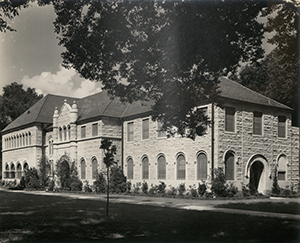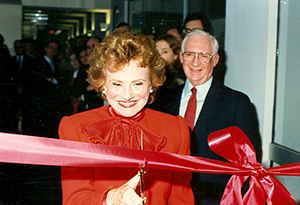History of the Turchin Library

While the exact beginning of the library is not clear, the 1914 Bulletin of the College of Commerce refers to the "Special Library of the College of Commerce and Business Administration". It was located in the office of Prof. Edwin Judd, who was an Associate Professor of Foreign Trade at the time. A gift of $500.00 was made to the library in 1915 by Theodore N. Vail, the first president of the American Telephone and Telegraph Co. This gift probably made it possible for the College to purchase a small core collection of books, which were housed for a number of years in the basement of Gibson Hall, along with the administrative offices. Vail himself was a pioneer in extending the technology and vision of long distance communication, and in this age of global business and communication, one feels as if he would feel very much at home. By 1916 the College had become one of 14 charter members of the newly formed American Association of Collegiate Schools of Business. One of the stipulations of accreditation was that the students have access to sufficient library resources. Even though the collection may have not been extensive by later standards, it did provide an incentive for the College to maintain a separate, professional library. In one source, Prof. Robert Elsasser is credited with setting up a more formal library, and the first librarian mentioned was Felica Jung.

In 1942, a bequest of $300,000 by the widow of Norman Mayer, a prominent New Orleans businessman, was made with the intent to establish buildings for both the College of Commerce, as well as its library. While funds were inadequate to build two edifices, the Norman Mayer building was dedicated in 1942, and expanded with a 3-story annex in 1949 to accommodate what was then called the Norman Mayer Library. The Librarian from 1944 through 1968 was Mrs. Oran Logan Marcoux, who had seen the library grow from a small collection in Gibson Hall to a sizable collection of appox. 20,000 volumes. The books were re-classified during the mid-60's from the Dewey Decimal system into the Library of Congress system, which was beginning to be used by most academic libraries in the U.S.
In 1969 Elizabeth Casellas joined the faculty as Director of the Library, as well as with the academic rank of Associate Professor. She had completed both a M.A. in education and a M.S. in librarianship from Columbia University in New York, and was the first library director with a professional library degree. The next several years marked several positive changes in the library, under the deanship of Peter Firmin.
By 1971 the library, having outgrown its space, consolidated several collections, and moved into the adjacent, newly renovated Tilton Hall, having been vacated by the Law Library. Tilton Hall was the site of the original Tulane University Library, and allowed the Library to increase its seating and shelving capacity. The budget of the Norman Mayer Library also almost quadrupled in the space of four years, increasing from $20,000 in 1968/69 to $75,000 by 1972/73. The staff of the library was increased, an open stack arrangement was implemented, and various service points, such as reference and circulation desks, were established.
In 1978 Mrs. Casellas was granted a medical retirement, and in 1979 Dorothy Whittemore, who had been on the staff of the Howard-Tilton Memorial Library, became the new director of the Norman Mayer Library, preparing the library for its move into its new quarters.

The Norman Mayer Library operated in Tilton Hall until the construction of Goldring/Woldenberg Hall in 1985. The Library occupied the entire 3rd floor of the new building, and was named after Tulane alumni Lillian and Robert Turchin, long-time donors. (In fact, the Turchin Library is probably the only library in the country to share its name with a baseball stadium, which was also named after the Turchins.)
Ms. Whittemore retired in 1992 after many years of service to Tulane, and was succeeded by Ms. Donna Bishop as Business Librarian. Ms Bishop began a multi-year project to integrate the library's holdings into Tulane's online catalog. Not only would the online catalog allow the collection of Turchin Library's books and periodicals to be indexed and searched, but books could also be checked out under the new computerized system.
In 1995, William Strickland was named as Business Librarian, transferring from Howard-Tilton, replacing Ms. Bishop, whose husband had been transferred to Chicago. During the first few years of his tenure, Library web pages were created, and the automation project was completed. Rapid advances in technology, especially the Web as an information delivery vehicle, also began to be seen in the library as a number of licensed, web-based databases were added as subscriptions. Some of these had been in a CD-ROM format, or were searched, online, by a Librarian, using specialized search commands. Other projects from the late 90's included a major weeding and print "downsizing" project, due, in part, to the fact that the library's space was being shared now with a number of staff offices. Also, as the faculty's direct access to electronic databases grew, many of the traditional print sources became outmoded and obsolete. In 2006, the Career Development Center was relocated to the 3rd floor of GWI, which meant that the 3rd floor was now divided into two parts, each with separate entrances. As the 21st century begins, the library continues to serve the Freeman School as an important support function, even though many changes have taken place in the almost 100 years of its history.